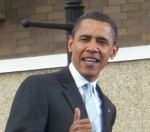Obama's Jobs Bill: A Reasonable Plan
 Photo: aflcio
Photo: aflcioHere are some quick thoughts on President Obama’s jobs plan:
– It’s reasonably big, at about 3% of GDP.
– It’s reasonably front-loaded. Goldman Sachs says it will raise 2012 GDP by about 1.5%–before any multiplier effects. Moody’s chief economist Mark Zandi thinks the effect on 2012 GDP will be about 2%. Expect more estimates in the 1-3% range for 2012; smaller for 2013.
– It’s reasonably well targeted. Unemployment insurance extensions will get spent. Infrastructure money gets spent and also builds stuff. As for the payroll tax: Who knows if it gets spent, but the point is to stimulate hiring, rather than spending.
– It’s reasonably well designed. The biggest problem with a payroll tax is that firms get it even for employees already on the books. But this time, the biggest payroll tax cut is only for firms raising their payrolls. This will yield a much bigger bang-for-each-buck. Early analyses have yet to realize how important this is.
– It’s reasonably timely. The usual argument against fiscal policy is that the spending only occurs by the time the economy is booming again. There’s no chance of that occurring. Perhaps this provides the confidence boost we need to counter double-dip concerns.
– It’s reasonably well focused. Tax credits for hiring the long-term unemployed will be very helpful in preventing the current recession doing long-term harm.
– It’s reasonably clever, removing the incentive to fire people, rather than reduce hours. (aka “Job sharing”)
– It’s reasonably evidence-based. Having the unemployed talk to a jobs counselor before extending benefits can have huge effects at minimal cost.
All told, it’s a very real plan and very specific. None of this is magic: Government gets more active when the market fails, and we pay it back when the market booms. This is all standard economics. There’s no gold-buggery, voodoo austerity or laughable Laffer-y. Obama’s not making up economics, he’s using simple tools to solve the obvious problems. And with long-term real interest rates close to zero, there’s no risk of this crowding out private investment
But let’s not expect miracles. Without the plan, GDP growth was expected to be so anemic that unemployment was expected to rise through 2012–partly due to the drag of reduced government spending in coming years. Obama’s plan eliminates this fiscal drag, but the economy has still gotta get its mojo back. So perhaps the long malaise turns in to the tepid recovery. But perhaps the Fed can help, too.
The biggest risk is that this plan provides another opportunity for Congress to prove itself incapable of addressing real macroeconomic concerns. If it does, watch for confidence to plummet just as it did following the debt-ceiling madness.
As for the politics: Ask a political scientist. But I wouldn’t want to have to explain a vote against this to my constituents, who are mad as hell about unemployment.

Comments